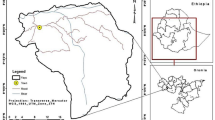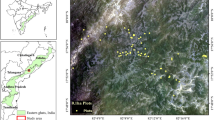Abstract
This study presents the utility of remote sensing (RS), GIS and field observation data to estimate above ground biomass (AGB) and stem volume over tropical forest environment. Application of those data for the modeling of forest properties is site specific and highly uncertain, thus further study is encouraged. In this study we used 1460 sampling plots collected in 16 transects measuring tree diameter (DBH) and other forest properties which were useful for the biomass assessment. The study was carried out in tropical forest region in East Kalimantan, Indonesia. The AGB density was estimated applying an existing DBH — biomass equation. The estimate was superimposed over the modified GIS map of the study area, and the biomass density of each land cover was calculated. The RS approach was performed using a subset of sample data to develop the AGB and stem volume linear equation models. Pearson correlation statistics test was conducted using ETM bands reflectance, vegetation indices, image transform layers, Principal Component Analysis (PCA) bands, Tasseled Cap (TC), Grey Level Co-Occurrence Matrix (GLCM) texture features and DEM data as the predictors. Two linear models were generated from the significant RS data. To analyze total biomass and stem volume of each land cover, Landsat ETM images from 2000 and 2003 were preprocessed, classified using maximum likelihood method, and filtered with the majority analysis. We found 158±16 m3·ha−1 of stem volume and 168±15 t·ha−1 of AGB estimated from RS approach, whereas the field measurement and GIS estimated 157±92 m3·ha−1 and 167±94 t·ha−1 of stem volume and AGB, respectively. The dynamics of biomass abundance from 2000 to 2003 were assessed from multi temporal ETM data and we found a slightly declining trend of total biomass over these periods. Remote sensing approach estimated lower biomass abundance than did the GIS and field measurement data. The earlier approach predicted 10.5 Gt and 10.3 Gt of total biomasses in 2000 and 2003, while the later estimated 11.9 Gt and 11.6 Gt of total biomasses, respectively. We found that GLCM mean texture features showed markedly strong correlations with stem volume and biomass.
Similar content being viewed by others
References
Anaya JA, Chuvieco E, Palacios-Orueta A. 2009. Aboveground biomass assessment in Colombia: A remote sensing approach. Forest Ecology and Management, 257(4): 1237–1246.
Barbosa PM, Stroppiana D, Gregoire JM, Pereira JMC. 1999. An assessment of vegetation fire in Africa (1981–1991): Burned areas, burned biomass, and atmospheric emissions. Global Biogeochemical Cycles, 13(4): 933–950.
Brown S. 1997. Estimating Biomass and Biomass Change of Tropical Forests: a Primer. Rome: FAO — Food and Agriculture Organization of the United Nations.
Brown S, Gaston G. 1995. Use of forest inventories and geographic information systems to estimate biomass density of tropical forests: Application to tropical Africa. Environmental Monitoring and Assessment, 38(2–3): 157–168.
Brown S, Gillespie AJR, Lugo AE. 1989. Biomass estimation methods for tropical forests with applications to forest inventory data. Forest Science, 35(4): 881–902.
Brown S, Iverson LR, Lugo AE. 1994. Land-use and biomass changes of forests in Peninsular Malaysia from 1972 to 1982: GIS approach. New York: Springer
Brown S, Lugo AE. 1984. Biomass of tropical forests — a new estimate based on forest volumes. Science, 223(4642): 1290–1293.
Brown S, Lugo AE. 1992. Aboveground biomass estimates for tropical moist forests of the Brazilian Amazon. Interciencia, 17: 8–18.
Chavez Jr. PS. 1988. An improved dark-object subtraction technique for atmospheric scattering correction of multispectral data. Remote Sensing of Environment, 24: 459–479.
Cloude S, Chen E, Li Z, Tian X, Pang Y, Li S, Pottier E, Ferro-Famil L, Neumann M, Hong W, Cao F, Wang YP, Papathanassiou KP. 2008. Forest structure estimation using space borne polarimetric radar: An ALOS PALSAR case study. In European Space Agency, (Special Publication) ESA SP, Beijing.
De Gier A. 2003. A new approach to woody biomass assessment in woodlands and shrublands. In: P. Roy (ed.), Geoinformatics for Tropical Ecosystems, pp. 161–198, India.
FAO. 1997. State of the world’s forests, Vol. 2006. Food and Agriculture Organization of the United Nations.
Foody GM. 2003. Remote sensing of tropical forest environments: towards the monitoring of environmental resources for sustainable development. International Journal of Remote Sensing, 24(20): 4035–4046.
Foody GM, Boyd DS, Cutler MEJ. 2003. Predictive relations of tropical forest biomass from Landsat TM data and their transferability between regions. Remote Sensing of Environment, 85(4): 463–474.
Hajnsek I, Kugler F, Papathanassiou K, Horn R, Scheiber R, Moreira A, Hoekman D, Davidson M. 2005. INDREX II — Indonesian airborne radar experiment campaign over tropical forest in L- and P-band: First results. In International Geoscience and Remote Sensing Symposium (IGARSS), Vol. 6, pp. 4335–4338, Seoul.
Houghton RA, Lawrence KT, Hackler JL., Brown S. 2001. The spatial distribution of forest biomass in the Brazilian Amazon: A comparison of estimates. Global Change Biology, 7(7): 731–746.
Huete AR. 1988. A Soil-Adjusted Vegetation Index (SAVI). Remote Sensing of Environment, 25: 295–309.
Huete AR., Liu H, Batchily K, Leeuwen WV. 1997. A comparison of vegetation indices over a global set of TM images for EOS-MODIS. Remote Sensing of Environment, 59(3): 440–451.
Isola M, Cloude SR. 2001. Forest height mapping using space-borne polarimetric SAR interferometry. In International Geoscience and Remote Sensing Symposium (IGARSS), Vol. 3, pp. 1095–1097, Sydney, NSW.
Jensen JR. 1996. Introductory Digital Image Processing: A remote Sensing Perspective, Second Edition edn. Prentice Hall.
Kaufman YJ, Tanre D. 1996. Strategy for direct and indirect methods for correcting the aerosol effect on remote sensing: from AVHRR to EOS-MODIS. Remote Sensing of Environment, 55: 65–79.
Ketterings QM, Coe R, Van Noordwijk M, Ambagau Y, Palm CA. 2001. Reducing uncertainty in the use of allometric biomass equations for predicting above-ground tree biomass in mixed secondary forests. Forest Ecology and Management, 146(1–3): 199–209.
Kuplich TM, Curran PJ, Atkinson PM. 2005. Relating SAR image texture to the biomass of regenerating tropical forests. International Journal of Remote Sensing, 26(21): 4829–4854.
Lefsky MA, Cohen WB, Harding DJ, Parker GG, Acker SA, Gower ST. 2002. Lidar remote sensing of above-ground biomass in three biomes. Global Ecology and Biogeography, 11(5): 393–399.
Lillesand TM, Kiefer RW. 1994. Remote Sensing and Image Interpretation, Third Edition edn. John Wiley & Sons, Inc.
Lu D. 2005. Aboveground biomass estimation using Landsat TM data in Brazilian Amazon. International Journal of Remote Sensing, 26(12): 2509–2525.
Lu D, Mausel P, Brondizio E, Moran E. 2004. Relationships between forest stand parameters and Landsat TM spectral responses in the Brazilian Amazon Basin. Forest Ecology and Management, 198(1–3): 149–167.
Lu DS. 2006. The potential and challenge of remote sensing-based biomass estimation. International Journal of Remote Sensing, 27(7): 1297–1328.
Mantel S. 1998. Soil and Terrain of the Labanan Area: Development of an environmental framework for the Berau Forest Management Project. Berau Forest Management Project, Berau.
Pinty B, Verstraete MM. 1991. GEMI: a non-linear index to monitor global vegetation from satellites. Vegetation, 101: 15–20.
Qi J, Kerr Y, Chehbouni A. 1994. External Factor Consideration in Vegetation Index Development. In Proceeding of Physical Measurements and Signatures in Remote Sensing, ISPRS, pp. 723–730.
Rahman MM, Csaplovics E, Koch B. 2005. An efficient regression strategy for extracting forest biomass information from satellite sensor data. International Journal of Remote Sensing, 26(7): 1511–1519.
Riaño D, Chuvieco E, Salas J, Aguado I. 2003. Assessment of different topographic corrections in Landsat-TM data for mapping vegetation types. IEEE Transactions on Geoscience and Remote Sensing, 41(5): 1056–1061.
Rouse JW, Haas RH, Schell JA, Deering DW. 1973. Monitoring vegetation systems in the great plains with ERTS. In: Third ERTS Symposium, NASA SP-351 I, Vol. I, pp. 309–317.
Roy PS, Ravan SA. 1996. Biomass estimation using satellite remote sensing data — An investigation on possible approaches for natural forest. Journal of Biosciences, 21(4): 535–561.
Sales MH, Souza Jr CM, Kyriakidis PC, Roberts DA, Vidal E. 2007. Improving spatial distribution estimation of forest biomass with geostatistics: A case study for Rondonia, Brazil. Ecological Modelling, 205(1–2): 221–230.
Samalca I. 2007. Estimation of Forest Biomass and its Error: A case in Kalimantan, Indonesia. Unpublished MSc. Thesis, ITC the Netherlands, Enschede.
Sist P, Nguyen-Thé N. 2002. Logging damage and the subsequent dynamics of a dipterocarp forest in East Kalimantan (1990–1996). Forest Ecology and Management, 165(1–3): 85–103.
Song C, Woodcock CE, Seto KC, Lenney MP, Macomber SA. 2001. Classification and change detection using Landsat TM data: When and how to correct atmospheric effects? Remote Sensing of Environment, 75(2): 230–244.
Steininger M. 2000. Satellite estimation of tropical secondary forest above-ground biomass: data from Brazil and Bolivia. International Journal of Remote Sensing, 21(6 & 7): 1139–1157.
Thenkabail PS, Stucky N, Griscom BW, Ashton MS, Diels J, Van der Meer B, Enclona E. 2004. Biomass estimations and carbon stock calculations in the oil palm plantations of African derived savannas using IKONOS data. International Journal of Remote Sensing, 25(23): 5447–5472.
Wijaya A. 2006. Comparison of soft classification techniques for forest cover mapping. Journal of Spatial Science, 51(2): 7–18.
Wijaya A, Marpu PR, Gloaguen R. 2008. Geostatistical texture classification of tropical rainforest in Indonesia. In: J.S. Alfred Stein, and Wietske Bijker (eds.), Quality Aspect in Spatial Data Mining, pp. 199–210. CRC Press Inc.
Author information
Authors and Affiliations
Corresponding author
Rights and permissions
About this article
Cite this article
Wijaya, A., Kusnadi, S., Gloaguen, R. et al. Improved strategy for estimating stem volume and forest biomass using moderate resolution remote sensing data and GIS. Journal of Forestry Research 21, 1–12 (2010). https://doi.org/10.1007/s11676-010-0001-7
Received:
Accepted:
Published:
Issue Date:
DOI: https://doi.org/10.1007/s11676-010-0001-7




